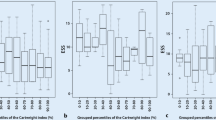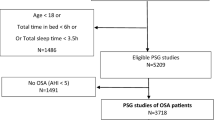Abstract
Purpose
Data on the impact of obstructive sleep apnea syndrome (OSAS) and its treatment on resting energy expenditure (REE) are currently few and conflicting. The purpose of the present study was to investigate the impact of OSAS on REE, as measured before and after sleep, and the changes in REE after a single continuous positive airway pressure (CPAP) application, for the first time in literature.
Methods
This is a nested case-control study. From the initial study population, two groups were formed, based on the results of nocturnal polysomnography: a group of male OSAS patients and a group of male, age-matched non-OSAS controls. REE was measured in both groups before and after sleep by indirect calorimetry, while patients repeated REE measurements before and after a single nasal CPAP application.
Results
Ninety-two male OSAS patients (45.3 ± 12.8 years old) and 19 male non-OSAS controls (50.8 ± 11.7 years old) were studied. REE/lean body mass (LBM) was higher among patients compared to controls both pre- (29.6 ± 12 vs 22.9 ± 7.9 kcal/kg; p = 0.022, correspondingly) and post-sleep (26.4 ± 9.6 vs 21.6 ± 9 kcal/kg; p = 0.047 correspondingly). REE/LBM decreased significantly after sleep in OSAS patients (p = 0.002), but not in controls; this difference was most evident among patients with more severe disease and higher desaturation. A single nasal CPAP application diminished the pre-post REE/LBM difference (30.3 ± 8.2 vs 28.3 ± 10.3 kcal/kg; p = 0.265), but only among responders.
Conclusions
In OSAS patients, REE values are high and vary significantly before and after sleep. A single nasal CPAP application diminishes this difference among responders, possibly through reversal of nocturnal desaturation.


Similar content being viewed by others
References
Epstein LJ, Kristo D, Strollo PJ Jr, Friedman N, Malhotra A, Patil SP, Ramar K, Rogers R, Schwab RJ, Weaver EM, Weinstein MD, Adult Obstructive Sleep Apnea Task Force of the American Academy of Sleep Medicine (2009) Clinical guideline for the evaluation, management and long-term care of obstructive sleep apnea in adults. J Clin Sleep Med 5(3):263–276
Diamanti C, Manali E, Ginieri-Coccossis M, Vougas K, Cholidou K, Markozannes E, Bakakos P, Liappas I, Alchanatis M (2013) Depression, physical activity, energy consumption, and quality of life in OSA patients before and after CPAP treatment. Sleep Breath 17(4):1159–1168
Punjabi NM (2008) The epidemiology of adult obstructive sleep apnea. Proc Am Thorac Soc 5(2):136–143
Young T, Palta M, Dempsey J, Skatrud J, Weber S, Badr S (1993) The occurrence of sleep-disordered breathing among middle-aged adults. N Engl J Med 328(17):1230–1235
Ucok K, Aycicek A, Sezer M, Fidan F, Akgun L, Akkaya M, Unlu M (2011) Resting metabolic rate and anthropometric measurements in male sleep apnea patients. Intern Med 50(8):833–838
Grunstein RR, Stenlöf K, Hedner J, Sjöström L (1995) Impact of obstructive sleep apnea and sleepiness on metabolic and cardiovascular risk factors in the Swedish Obese Subjects (SOS) Study. Int J Obes Relat Metab Disord 19(6):410–418
Leung RS, Bradley TD (2001) Sleep apnea and cardiovascular disease. Am J Respir Crit Care Med 164(12):2147–2165
Ip MSM, Lam B, Ng MMT, Lam WK, Tsang KWT, Lam KSL (2002) Obstructive sleep apnea is independently associated with insulin resistance. Am J Respir Crit Care Med 165(5):670–676
Phillips BG, Hisel TM, Kato M, Pesek CA, Dyken ME, Narkiewicz K, Somers VK (1999) Recent weight gain in patients with newly diagnosed obstructive sleep apnea. J Hypertens 17(9):1297–1300
Phillips BG, Kato M, Narkiewicz K, Choe I, Somers VK (2000) Increases in leptin levels, sympathetic drive, and weight gain in obstructive sleep apnea. Am J Physiol Heart Circ Physiol 279(1):H234–H237
Traviss KA, Barr SI, Fleming JA, Ryan CF (2002) Lifestyle-related weight gain in obese men with newly diagnosed obstructive sleep apnea. J Am Diet Assoc 102(5):703–706
De Jonge L, Zhao X, Mattingly MS, Zuber SM, Piaggi P, Csako G, Cizza G, NIDDK Sleep Extension Study Group (2012) Poor sleep quality and sleep apnea are associated with higher resting energy expenditure in obese individuals with short sleep duration. J Clin Endocrinol Metab 97(8):2881–2889
Ryan CF, Love LL, Buckley PA (1995) Energy expenditure in obstructive sleep apnea. Sleep 18(3):180–187
Stenlöf K, Grunstein R, Hedner J, Sjöström L (1996) Energy expenditure in obstructive sleep apnea: effects of treatment with continuous positive airway pressure. Am J Physiol 271(6 Pt 1):E1036–E1043
Lin C-C, Chang K-C, Lee K-S (2002) Effects of treatment by laser-assisted uvuloplasty on sleep energy expenditure in obstructive sleep apnea patients. Metabolism 51(5):622–627
Marin JM, Carrizo SJ, Vicente E, Agusti AGN (2005) Long-term cardiovascular outcomes in men with obstructive sleep apnoea-hypopnoea with or without treatment with continuous positive airway pressure: an observational study. Lancet 365(9464):1046–1053
Dounoghue WC (2004) How to measure your % body fat, 8th edn. Creative Health products, Plymouth, 22 p
Compher C, Frankenfield D, Keim N, Roth-Yousey L, Evidence Analysis Working Group (2006) Best practice methods to apply to measurement of resting metabolic rate in adults: a systematic review. J Am Diet Assoc 106(6):881–903
Harris JA, Benedict FG (1918) A biometric study of human basal metabolism. Proc Natl Acad Sci U S A 4(12):370–373
Hins J, Sériès F, Alméras N, Tremblay A (2006) Relationship between severity of nocturnal desaturation and adaptive thermogenesis: preliminary data of apneic patients tested in a whole-body indirect calorimetry chamber. Int J Obes 30(3):574–577
Bland RM, Bulgarelli S, Ventham JC, Jackson D, Reilly JJ, Paton JY (2001) Total energy expenditure in children with obstructive sleep apnoea syndrome. Eur Respir J 18(1):164–169
O’Driscoll DM, Turton AR, Copland JM, Strauss BJ, Hamilton GS (2013) Energy expenditure in obstructive sleep apnea: validation of a multiple physiological sensor for determination of sleep and wake. Sleep Breath 17(1):139–146
Kezirian EJ, Kirisoglu CE, Riley RW, Chang E, Guilleminault C, Powell NB (2008) Resting energy expenditure in adults with sleep disordered breathing. Arch Otolaryngol Head Neck Surg 134(12):1270–1275
Major GC, Sériès F, Tremblay A (2007) Does the energy expenditure status in obstructive sleep apnea favour a positive energy balance? Clin Investig Med Med Clin Exp 30(6):E262–E268
Caron AM, Stephenson R (2010) Energy expenditure is affected by rate of accumulation of sleep deficit in rats. Sleep 33(9):1226–1235
McEwen BS, Seeman T (1999) Protective and damaging effects of mediators of stress. Elaborating and testing the concepts of allostasis and allostatic load. Ann N Y Acad Sci 896:30–47
Vgontzas AN, Mastorakos G, Bixler EO, Kales A, Gold PW, Chrousos GP (1999) Sleep deprivation effects on the activity of the hypothalamic-pituitary-adrenal and growth axes: potential clinical implications. Clin Endocrinol (Oxf) 51(2):205–215
Butterfield GE, Gates J, Fleming S, Brooks GA, Sutton JR, Reeves JT (1992) Increased energy intake minimizes weight loss in men at high altitude. J Appl Physiol (1985) 72(5):1741–1748
Mawson JT, Braun B, Rock PB, Moore LG, Mazzeo R, Butterfield GE (2000) Women at altitude: energy requirement at 4,300 m. J Appl Physiol (1985) 88(1):272–281
Kayser B, Verges S (2013) Hypoxia, energy balance and obesity: from pathophysiological mechanisms to new treatment strategies. Obes Rev 14(7):579–592
Gautier H, Bonora M, M’Barek SB, Sinclair JD (1991) Effects of hypoxia and cold acclimation on thermoregulation in the rat. J Appl Physiol Bethesda Md (1985) 71(4):1355–1363
Oltmanns KM, Gehring H, Schultes B, Schweiger U, Born J, Fehm HL, Peters A (2006) Persistent suppression of resting energy expenditure after acute hypoxia. Metabolism 55(5):669–675
Raguso CA, Luthy C (2011) Nutritional status in chronic obstructive pulmonary disease: role of hypoxia. Nutrition 27(2):138–143
Drager LF, Lopes HF, Maki-Nunes C, Trombetta IC, Toschi-Dias E, Alves MJ, Fraga RF, Jun JC, Negrão CE, Krieger EM, Polotsky VY, Lorenzi-Filho G (2010) The impact of obstructive sleep apnea on metabolic and inflammatory markers in consecutive patients with metabolic syndrome. PLoS One 5(8), e12065
Lavie L (2003) Obstructive sleep apnoea syndrome—an oxidative stress disorder. Sleep Med Rev 7(1):35–51
Jullian-Desayes I, Joyeux-Faure M, Tamisier R, Launois S, Borel A-L, Levy P, Pepin JL (2014) Impact of obstructive sleep apnea treatment by continuous positive airway pressure on cardiometabolic biomarkers: a systematic review from sham CPAP randomized controlled trials. Sleep Med Rev. doi:10.1016/j.smrv.2014.07.004
Chin K, Shimizu K, Nakamura T, Narai N, Masuzaki H, Ogawa Y, Mishima M, Nakamura T, Nakao K, Ohi M (1999) Changes in intra-abdominal visceral fat and serum leptin levels in patients with obstructive sleep apnea syndrome following nasal continuous positive airway pressure therapy. Circulation 100(7):706–712
Author information
Authors and Affiliations
Corresponding author
Rights and permissions
About this article
Cite this article
Fekete, K., Boutou, A.K., Pitsiou, G. et al. Resting energy expenditure in OSAS: the impact of a single CPAP application. Sleep Breath 20, 121–128 (2016). https://doi.org/10.1007/s11325-015-1194-y
Received:
Revised:
Accepted:
Published:
Issue Date:
DOI: https://doi.org/10.1007/s11325-015-1194-y




